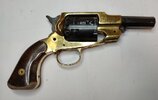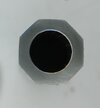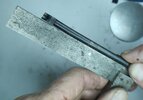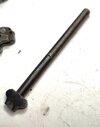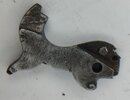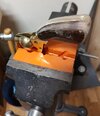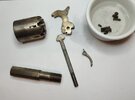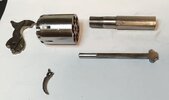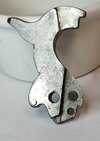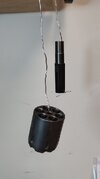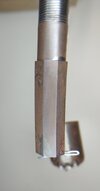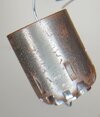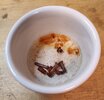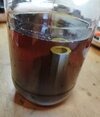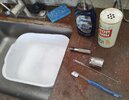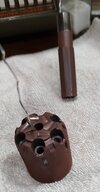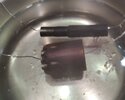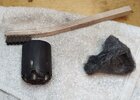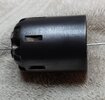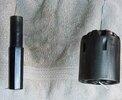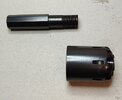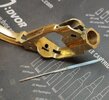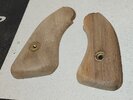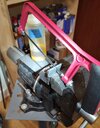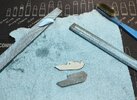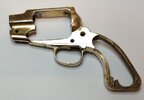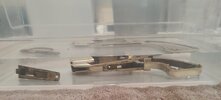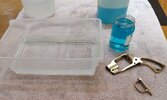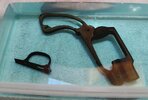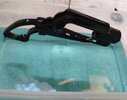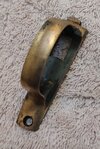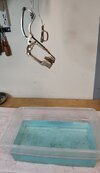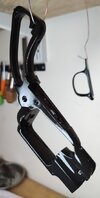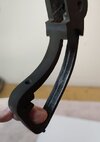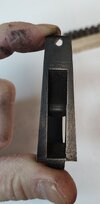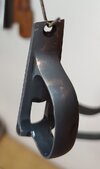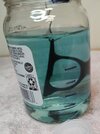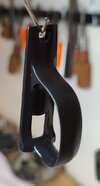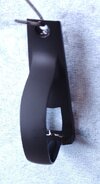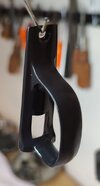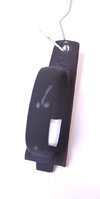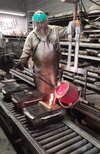windini
Member
- Joined
- Sep 4, 2020
- Messages
- 180
I didn't think I had too much time on my hands, but apparently... Some part of me decided to get moving on turning my brass framed FIE 1858 into a snub-snouted Bulldog.
Bought it well used some time ago; loading lever did not move well, but I test fired it and it didn't blow me up. Rather than order a new lever, link pin, and rammer, I decided to chop it up.
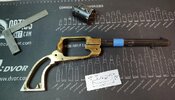
Cut the BBL to 3-1/2"
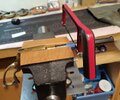
Then I deployed my homemade "Frame Wrench!" Don't laugh; it worked! After lots of Kroil and a butane chef's torch, it did.
Don't laugh; it worked! After lots of Kroil and a butane chef's torch, it did.
The barrel is tapered, so clamping it was challenging. You can't see them, but there are 2 homemade copper sheet vise jaw pads btw the barrel and the jaws. They are just malleable enough to conform to the bbl taper and get a solid grip. I think the copper shim stock was .010" thick.
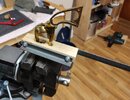
I'm ditching the lever/arbor pin retainer in favor of a quick-release to be modeled after the commercially available one. I'm going to (try to) make mine out of brass so it'll match the frame (which I plan to blacken or darken significantly).
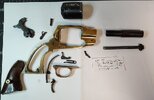
Started rounding off the grip grame. I'll strip the walnut panels that came on it, then shape them to fit. If I decide to round the backside enough to tag the grip panel retainer posts, I'll drill a hole farther in, add a new cross pin, then make a new set of grip panels.
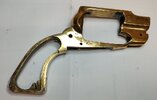
The "plan," such as it is at present, is to blacken the brass, bring all the steel back to white, then rust blue the barrel & cylinder and put a faux color case hardening on the hammer & trigger. I tried using some Super Blue to blacken some brass bits I had lying around, but found it works decently on some things but abysmally on others. I'll get some Brass Black & see if it's noticeably better, and I've got a buddy looking for some Pro-level brass blackener for me as well.
So far, so fun!
Bought it well used some time ago; loading lever did not move well, but I test fired it and it didn't blow me up. Rather than order a new lever, link pin, and rammer, I decided to chop it up.

Cut the BBL to 3-1/2"

Then I deployed my homemade "Frame Wrench!"
The barrel is tapered, so clamping it was challenging. You can't see them, but there are 2 homemade copper sheet vise jaw pads btw the barrel and the jaws. They are just malleable enough to conform to the bbl taper and get a solid grip. I think the copper shim stock was .010" thick.

I'm ditching the lever/arbor pin retainer in favor of a quick-release to be modeled after the commercially available one. I'm going to (try to) make mine out of brass so it'll match the frame (which I plan to blacken or darken significantly).

Started rounding off the grip grame. I'll strip the walnut panels that came on it, then shape them to fit. If I decide to round the backside enough to tag the grip panel retainer posts, I'll drill a hole farther in, add a new cross pin, then make a new set of grip panels.

The "plan," such as it is at present, is to blacken the brass, bring all the steel back to white, then rust blue the barrel & cylinder and put a faux color case hardening on the hammer & trigger. I tried using some Super Blue to blacken some brass bits I had lying around, but found it works decently on some things but abysmally on others. I'll get some Brass Black & see if it's noticeably better, and I've got a buddy looking for some Pro-level brass blackener for me as well.
So far, so fun!
Last edited:


